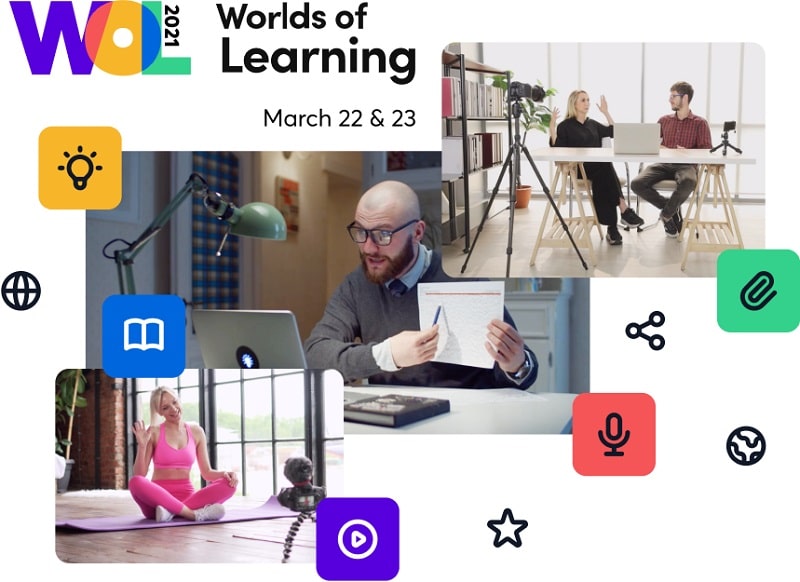Growing your mailing list is a balancing act of quantity and quality. Having an email list of 100,000 people who don’t respond to your brand is unhelpful to the point of being counterproductive – it simply becomes expensive to maintain.
On the flip side, having a tiny group of activated people in your mailing list doesn’t always help you scale what you want to achieve.
A good mailing list is made up of an active but scalable audience.
And what’s a great way to attract an active but scalable audience? Well, okay, the title was a bit of a giveaway, but you’ve got it! Virtual events.
Virtual events are one of the most efficient ways to capture email addresses and activate your audience. HeySummit sees an average of 2643 attendees per event – that’s a lot of email addresses!
Even beyond this, virtual events are a highly effective means of cross-pollination and a fantastic way to repurpose content. Most importantly, virtual events demonstrate your value through the power of experience.
Here are 5 ways to grow your mailing list with a virtual event:
1. Know Your Why

Know why you want to grow your list.
Now we’re not trying to be abstract or philosophical here, but knowing why you want to grow your email list is absolutely crucial to your marketing strategy. Ask yourself:
- Do I want to spread knowledge?
- Am I trying to sell a product?
- Do I want to grow and activate a community?
- Is my ego a motivator?
- Am I aiming to establish myself as a leader in my field?
If you’re uncertain why you want to grow your email list, you’re going to have a pretty tough time trying. Simple as that. Knowing your ‘why’ is fundamental to communicating clearly and effectively with both your attendees and speakers.
Write down at least three reasons you want to grow your email list and use this to guide your strategy.
If ego is a motivator, for example, embrace it! Thought leadership is a prevalent and valid reason to want to grow your email list. Focus on networking and aligning yourself with experts in your field. Entrepreneurial coach Doc Williams recruits his clients as speakers on topics such as How to Brand Yourself as an Influencer. A firm believer in letting his work speak for itself, Doc’s virtual events establish social proof and thought leadership.

2. Build an Attendee Persona

Treat your event, even if it’s free, just like a product. This will hone in your focus for growing your mailing list. Like any product, your event needs a customer persona. Or, in this case, an attendee persona.
An attendee persona is a very detailed profile of the type of person you’re trying to reach. When you know your attendee, you know what’s going to make them sign up.
- What does your typical attendee look like?
- How old are they?
- What are they interested in?
- What are their pain points?
- What was their favorite song at high school?
The more detailed, the better.
For example, Siobhan Farr’s Digital Nomads Beyond 50 2021 summit was built on a clear attendee persona. This persona includes but is not limited to:
- An aspiring digital nomad in their late 40s and beyond
- Based in the United States
- Without children or with children who have flown the nest
- Now considering retirement due to COVID -19
- Their concerns include: understanding how to pay tax whilst traveling, generating new income streams, being a good guest in a foreign country, etc.
Siobhan sought speakers to address these pain points to capture and maintain attendee attention. Over 130 people signed up to Siobhan’s summit, bumping her Digital Nomads Beyond 50 Network Facebook group to 388 members.

Just as it is essential to know who your event is for, you need to be equally as clear with yourself as to who it is not for. For example, Siobhan’s summits are not for people under 47 years old or those unable to work remotely. If you can’t think of anyone that your event isn’t for, it’s far too broad.
When was the last time you signed up for something you’re vaguely familiar with? Your sign-ups will be from people who see your event as something that directly speaks to them. Don’t underestimate the power of your attendee persona – it will guide everything you do.
3. Find Your Niche
Once you’ve narrowed your focus to your attendee persona, narrow it even further to one of their problems.
We’re serious – you need a microscope on this thing. You’ve heard the saying, “If you try to please everyone, you’ll please no one.” Well, the same applies to your attendee’s problems. If you try to solve all your attendee’s problems, you won’t end up solving any of them.
When creating your event, start with the problem. Whatever you do, don’t start with a solution and go about finding a problem to attach to it haphazardly. It sounds simple, but it’s frustratingly easy to get it upside down. Fall in love with the problem.
There may be loads of problems you’re absolutely smitten with. That’s great! In time, you’ll address those too. Just make sure to establish your credibility with one problem first before moving on to the next. The other problems won’t get jealous, we promise.
Writing coach Daniel Wallace’s first summit, Escape the Plot Forest, really honed in on a niche. Created for aspiring fiction authors, it focused on one aspect of writing: plot.

Escape the Plot Forest attracted over 3000 attendees, netting over $26,000 in revenue. Not only did Daniel get a lot more sign-ups than he was expecting, but he also grew and activated his online community. Trust us, finding your niche works.
4. Cross-Pollinate with Your Speakers
Virtual events are strong sources of cross-pollination.
Cross-pollination occurs when individuals or companies combine their talents to extend their reach. When you invite speakers to your event, they get access to your audience. And guess what? You get access to theirs!
Having your speaker’s audience sign up for your event is a fantastic way to capture email addresses. If you have several speakers – that’s more email addresses!
It can be uncomfortable asking your speakers to promote your event. We know this is easier said than done but push through this. It’ll be worth it.
When you invite speakers to your event, you’re giving them the opportunity to grow their own list as well. Be upfront with your speakers with how you expect them to share your event with their audience. If some people aren’t comfortable with that, c’est la vie! You’ll find another speaker who is.
At the same time, make it as easy as possible for speakers to share your event. Ask them what their outreach strategy is and what you can do to help them with it. Provide them with copy, prompts, whatever they need.
Product-Led Growth Pioneer Wes Bush cross-pollinates in quarterly ProductLed virtual events. His speakers are people his attendees recognize as strong players in the product-led space. Bringing together so many experts is fantastic for attracting new leads, growing Wes’s email list, and in turn providing great promo for his book, Product-Led Growth: How To Build a Product That Sells.

Cross-pollination is one of the most efficient ways to grow your list – take advantage!
5. Maximise Your Content
Evergreen Summits
Collecting event sign-ups before launch day is not the only opportunity you have in your event marketing strategy to grow your list.
Your event is not a single moment. You have its build-up, the event itself, and the aftercare. Growing your mailing list is as much about nurture as it is capture. Don’t forget about your new sign-ups once the event is over – give them a reason to stay.
Most of the events run on HeySummit are ‘Evergreens’ – they’re left open once they’re over. They’re great for SEO _and _for people to discover your event after the fact.
The Worlds of Learning summit for course creators and entrepreneurs is a great example of an open event. Since its March 2021 launch, all-access passes and replays to specific talks remain available. Record your event, keep it open, and don’t take away any future opportunities to grow your list.

Repurpose
Events give you _so _much content. Repurpose it! If your event had 30 talks, for example, that’s 30 podcast episodes, 30 blog posts, and 30 social media campaigns, all with their own call-to-action to join your mailing list. The more events, the more content you provide, and the easier it is to grow your list.
Your event shouldn’t be an isolated one-off. Make it work with your marketing flow. If you’re a podcaster and you’re using events to capture leads, talk about your events on your podcast and talk about your podcast at your events. This way, you’re giving people several reasons to sign up across channels.
Related Content
- How to Organize a Live Summit: 11 Tips
- 12 Best Email Marketing Tips for Entrepreneurs
- 5-Step Guide To Mastering Your Paid Search Keyword Strategy
- 3 Critical Ways to Build Your Blog and Newsletter Audience
- What is a Landing Page?
The Rundown
The best way to build a list is to have people believe in the value you’re providing. Hosting a virtual event is one of the best ways to demonstrate your value. When done well, virtual events show your audience that not only do you know your value, and you know them. Hone in your focus and:
- Know Your Why
- Build Your Attendee Persona
- Find Your Niche
- Cross-Pollinate with Your Speakers
- Maximise Your Content
Go on – get on that (virtual) stage!

Written by our guest writer Rob Gelb, Founder and CEO of HeySummit
He loves tech, cool projects, and cheer-leading awesome people.



